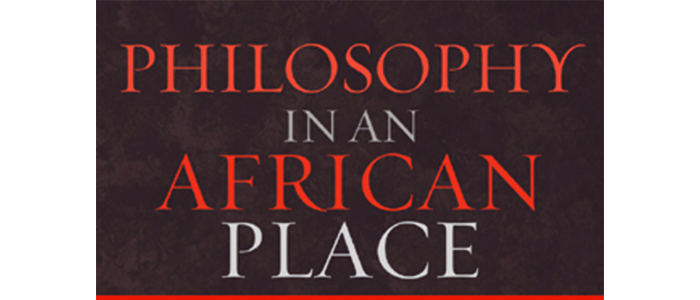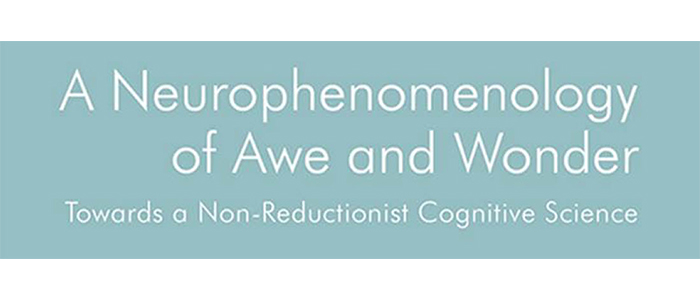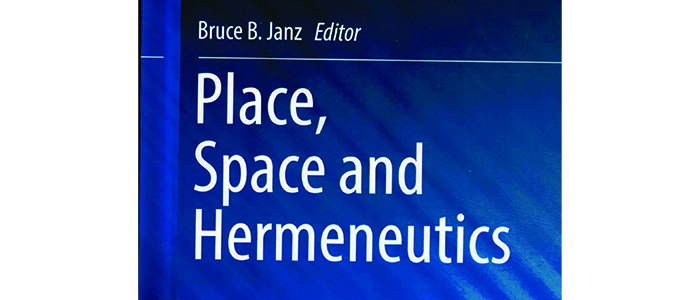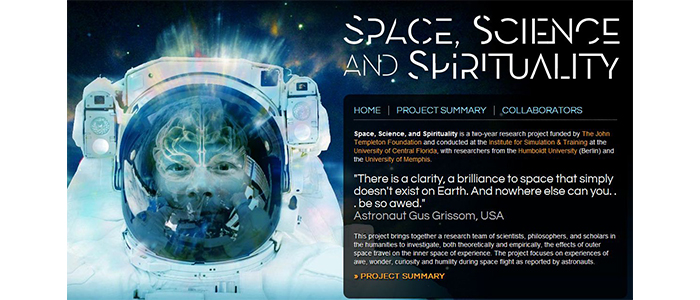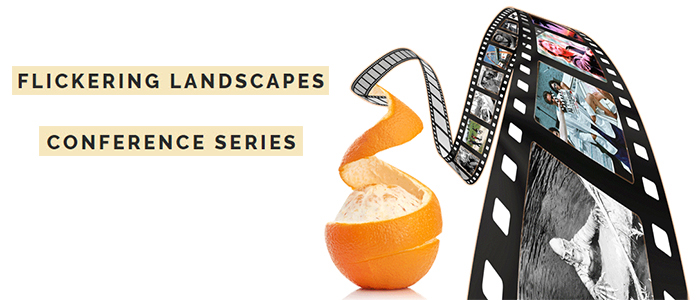Websites
- An Atlas of Cyberspace.
- The Body is Back: Communication in Cyberspace.
- Computing and Place Links.
- The Cyberarts Web: Cyberspace and Critical Theory.
- Cyberspace.
- Cyberspace, Hypertext, and Critical Theory.
- CyberTextSpace (Karin Wenz).
- Elastic Time and Space.
- The Geography of Cyberspace Directory.
- Grafedia.net – hyperlinked physical world messages, accessible by email.
- Headmap.org – place, space & mapping in virtual world
- HyperGeo.
- Imaging Koenigsburg/Kalingrad.
- Imagining Place Online.
- Information Place & Space Links.
- International Society for Presence Research.
- IP-III – A Project Showing the Intrinsic Space of the Internet.
- Michael Heim..
- <Paper or Plastic?> Defining the Field.
- Presence Research.org.
- Spaceless.com.
- Telerelating: Explorations of Social Presence and Mixed Realities.
- Transparency Now – Simulated Places.
Journals
- CyberPsychology and Behavior.
- International Journal
of Design Computing.- Special Issue: Designing Virtual Worlds.
- Journal of Society and Information.
- Journal of Virtual Environments.
- Presence:
Teleoperators and Virtual Environments.- Presence Research.org – online companion for journal.
- Virtualnomics.
On-line Bibliographies
- A Bibliography on Spatial Reasoning.
- Presence Bibliography.
- Presence Bibliography (International Society for Presence Research).
Courses and Programs
- Place, Identity and the Networked World (Michael Curry)
- Place Identity in Digital Production (Malcolm McCullogh)
Email Discussion Lists
Presence-L (an email address to send a subscription request)
Online Paper Collections
Presence Papers http://www.presence-research.org/papers.html.
General Bibliography
Aarseth, Espen. “Allegories of Space: The Question of Spatiality in Computer Games.” http://www.hf.uib.no/hi/espen/papers/space/.
Adams, Paul. “Network Topologies and Virtual Place” Annals of the Association of American Geographers 88:1 (1998):88-106.
Adams, Paul. “Computer Networks and Virtual Place Metaphors” Geographical Review 87:2 (1997):155-171, Special Issue on Cyberspace and Geographical Space, guest editors, P. Adams and B. Warf.
Adams, Paul & Barney Warf. “Introduction: Cyberspace and Geographical Space” Geographical Review 87:2 (1997):139-145, Special Issue on Cyberspace and Geographical Space, guest editors, P. Adams and B. Warf.
Anders, Peter. “Anthropic Cyberspace: Defining Electronic Space from First Principles.” Leonardo 34:5 (2001).
Aufenanger, Stefan. “How Children Envisage Virtual Space; Die Vorstellungen von Kindern vom virtuellen Raum.” Diskurs 10:1 (2000): 25-27.
Barta-Smith, Nancy A & James T Hathaway. “Making Cyber-spaces Into Cyber-Places.” Journal of Geography 99:6 (2000): 253ff.
Bell, Steven. Toward a Virtual Reality Aesthetic Programming Interface. http://ncca.bournemouth.ac.uk/Staff/steveb/vrapi/C&C2D.html.
Benyon, David. “Beyond Navigation as Metaphor.” http://www.dcs.napier.ac.uk/~dbenyon/EuroDL.html.
Betancourth, Carlos. “Virtuality, Space, and Control.” http://www.periferia.org/publications/vsc.html.
Bingham, Nick. “Objections: from technological determinism towards geographies of relations.” Environment and Planning D-Society & Space 14 (1996): 635-657.
Bogard, William. “Simmel in Cyberspace: Strangeness and Distance in Postmodern Communications.” Space and Culture 4-5 (2000): 23-46.
Borer, Michael Ian. “The Cyborgian Self: Toward a Critical Social Theory of Cyberspace.” http://www.reconstruction.ws/023/borer.htm.
Boskovic, Aleksandar. “Virtual Places: Imagined Boundaries and Hyperreality in Southeastern Europe.” http://www.ctheory.net/text_file.asp?pick=97.
Bowman, D., E. Davis, L. Hodges & A. Badre. “Maintaining Spatial Orientation during Travel in an Immersive Virtual Environment.” Presence: Teleoperators and Virtual Environments 8:6 (1999): 618 – 631.
Bruns, Axel. “The n-Dimensional Village: Coming to Terms with Cyberspatial Topography.” http://www.media-culture.org.au/9811/village.html.
Bryant, Rebecca. “What Kind of Space is Cyberspace?” http://www.mic.ul.ie/stephen/cyberspace.pdf.
Carazo-Chandler, Christian. “Conceptualizing Geographies in a Virtual World Environment.” http://www.itu.dk/people/dali/Conceptualising%20Geography%20in%20a%20Virtual%20World%20Environment.doc.
Chalmers, Matthew. “Place, Media, and Activity.” http://machen.mrl.nott.ac.uk/PublicationStore/2001-chalmers-4.pdf.
Chalmers, Matthew. “Theory and Practice in the City Project.” http://machen.mrl.nott.ac.uk/PublicationStore/2001-chalmers.pdf.
Champion, Erik. “Virtual Places.” http://www.arbld.unimelb.edu.au/~erikc/papers/VirtualPlaces.pdf.
Champion, Erik. “Cultural Presence.” http://www.arbld.unimelb.edu.au/~erikc/papers/CulturalPresence.pdf.
Champion, Erik and Bharat Dave. “Where Is This Place?” http://www.arbld.unimelb.edu.au/~erikc/papers/ACADIA2002.pdf.
Champion, Erik, Bharat Dave and Ian Bishop. “Interaction, Agency, and Artefacts.” http://www.arbld.unimelb.edu.au/~erikc/papers/CAADFUTURES2003.pdf.
Charitos, D., “Designing Space in Virtual Environments for Aiding Wayfinding Behavior.” Department of Architecture, University of Strathclyde. The fourth UK VR-SIG Conference, Brunel University, 1st November 1997. http://citeseer.nj.nec.com/charitos97designing.html.
Chung, Misin. A Sacred Space in Cyberspace. http://depts.washington.edu/dmachine/mschung/thesis/presentation/01-thesis.htm.
Clodius, Jen. “Concepts of Place and Space in a Virtual Community.” http://www.dragonmud.org/people/jen/space.html.
Corngold, Stanley. “Reading in the Age of Media, Computers, and Internet.” http://www.liternet.bg/iser/corn1.htm.
Crang, Mike, Phil Crang , Jon May, eds. Virtual Geographies: Bodies, Space and Relations. London & New York: Routledge, 1999.
Curry, Michael. “Cyberspace and cyberplaces: Rethinking the identity of individual and place.” http://dpub36.pub.sbg.ac.at/ectp/CURRY_P.HTM.
Curry, Michael and Munroe Eagles. “Geographies of the Information Society: Place and Identity in an Age of Technologically Regulated Movement.” http://www.ncgia.ucsb.edu/Publications/Varenius_Reports/Place_and_Identity.pdf.
Darkin, R., T. Allard & L. Achille. “Spatial Orientation and Wayfinding in Large-Scale Virtual Spaces: An Introduction.” Presence: Teleoperators and Virtual Environments 7:2 (1998): 101-107.
Davis, Stephen. Media Space: An Analysis of Spatial Practices in Planar Pictorial Media. Ph.D. Thesis http://www.cea.mdx.ac.uk/cea/CEA_shared/Staff_Stephen/Personal/MediaSpacePhD_COMPLETE.pdf NOTE: 22 Mb file.
Dieberger, Andreas. “Social connotations of spatial metaphors and their influence on (direct) social navigation.” http://juggle5.50megs.com/WORK/publications/SocNav_Stockholm_3_98.html.
Dodd, Adam. “The Truth Is Over There’: Is There Room for Space in Postmodernity?” http://www.media-culture.org.au/9811/truth.html.
Dodge, Martin. “Avatars, Identity and Meta-Place: The Geography of a 3-D Virtual World on the Internet.” http://www.casa.ucl.ac.uk/martin/varenius_placeidentity.pdf.
Dodge, M. and Kitchin, R.M. Mapping Cyberspace. Routledge, London. 2000. See this website on the book.
Dodge, M. and Kitchin, R.M. Atlas of Cyberspace. Addison-Wesley, 2001.
Driskell, Robyn Bateman and Larry Lyon. “Are Virtual Communities True Communities? Examining the Environments and Elements of Community.” City and Community 1:4 (December 2002): 373-390.
Durand, Alain-Philippe. Un monde techno. Nouveaux espaces électroniques dans le roman français des années 1980-1990. Berlin: Weidler Buchverlag, 2004.
Evans, Karen. Maintaining Community in the Information Age: The Importance of Trust, Place and Situated Knowledge. Palgrave Macmillan, 2005.
Fischer, Claude S. and R. M Jackson etc., Networks and Places. New York: Free Press, 1977.
Fisher, Dana. “On Utopias and Dystopias: Toward an Understanding of the Discourse Surrounding the Internet.” http://www.ascusc.org/jcmc/vol6/issue2/fisher.html.
Flanagan, Mary. “Navigating the narrative in space: Gender and spatiality in virtual worlds.” Art Journal (Fall 2000) http://www.findarticles.com/p/articles/mi_m0425/is_3_59/ai_66238371.
Fletcher, Gordon. “All That is Virtual Bleeds Into Reality, Part One” http://www.spaceless.com/papers/1.htm.
Fletcher, Gordon. “All That is Virtual Bleeds Into Reality, Part Two” http://www.spaceless.com/papers/8.htm.
Fletcher, Gordon. “…Excavating Posts.” http://www.spaceless.com/papers/3.htm.
Fletcher, Gordon. “…’Better Than (Real) Life: Cyberspace as Urban Space.” http://www.spaceless.com/papers/10.htm.
Fraim, John. “The Cyberspace Battle Against Place.” http://www.symbolism.org/writing/articles/internal/cyberspace/home.html.
Galin, Jeffrey R. and Joan Latchaw. “Heterotopic Spaces Online: A New Paradigm for Academic Scholarship and Publication” http://english.ttu.edu/kairos/3.1/coverweb/galin/.
Goldate, Steven. “The ‘Cyberflâneur’ -Spaces and Places on the Internet.” http://www.ceramicstoday.com/articles/050498.htm.
Gotved, Stine. “Spatial Dimensions in Online Communities.” Space and Culture 5:4 (November 2002): 405-414.
Graham, Stephen. “The End of Geography or the Explosion of Place? Conceptualizing Space, Place and Information Technology.” Progress in Human Geography 22:2 (June 1998): 165-185.
Graham, Stephen. “Spaces of surveillant simulation: new technologies, digital representations, and material geographies.” Environment and Planning D-Society & Space 16 (1998): 483-504.
Greenhill, Anita and Gordon Fletcher. “The Social Construction of Electronic Space.” http://www.spaceless.com/papers/12.htm.
Greenhill, Anita. “…Virtually There: The Social Construction of Computer Mediated Identity.” http://www.spaceless.com/papers/13.htm.
Gu, Ning & Mary Lou Maher. “Designing Virtual Architecture: From Place to User Centred Design” International Journal of Design Computing 4 (2002). http://www.arch.usyd.edu.au/kcdc/journal/vol4/gu/index.html.
Hill, Leslie. “Terra Incognita.” http://www.reconstruction.ws/023/hill.pdf.
Hillis, Ken. Digital sensations: space, identity, and embodiment in virtual reality. Minneapolis: University of Minnesota Press, 1999.
Curry, Michael R. “Review of Ken Hillis, Digital Sensations: Space, Identity, and Embodiment in Virtual Reality.” Annals of the Association of American Geographers 91:4 (2001): 771ff.
Holloway, S. L. and G. Valentine. “Placing cyberspace: Processes of Americanization in British children’s use of the Internet.” Area 33:2 (2001): 153-160.
Horan, Thomas A. Digital Places: Building Our City of Bits. Washington DC: Urban Land Institute, 2000.
Ito, Mizuko. “Network Localities: Identity, Place, and Digital Media.” http://www.itofisher.com/PEOPLE/mito/locality.pdf.
Jacobs, W. Jake, Holly E. Laurance, Kevin G. F. Thomas. “Place Learning in Virtual Space I: Acquisition, Overshadowing, and Transfer.” Learning and Motivation 28:4 (Nov 1997): 521-541.
Janelle, Donald G. and David C. Hodge, eds. Information, place, and cyberspace: Issues in accessibility. Heidelberg and New York: Springer, 2000.
Jenkins, Henry. “Game Design as Narrative Architecture” http://web.mit.edu/21fms/www/faculty/henry3/games&narrative.html.
Jenkins, Henry & Kurt Squire. “The Art of Contested Spaces” http://web.mit.edu/21fms/www/faculty/henry3/contestedspaces.html.
Kalay, Y & Marx, J. “Changing the Metaphor: Cyberspace as a Place.” Digital Design – Research and Practice, Proceedings of the 10th International Conference on Computer Aided Architectural Design Futures. Mao-Lin Chiu, Jin-Yeu Tsou, Thomas Kvan, Mitsuo Morozumi, and Tay-Sheng Jeng (eds.), Dordrecht: Kluwer Academic Publishers, 2003.
Kalay, Y. & Marx. J. “Architecture and the Internet: Designing Places in Cyberspace.” Proceedings
of ACADIA 2001: Reinventing the Discourse, W. Jabi (ed.) (2001): 230-240.
Kellogg, Wendy and Thomas Erickson. “Social Translucence, Collective Awareness, and the Emergence of Place: A Position Paper for The Role of Place in Shaping Virtual Community.” http://modiin.njit.edu/cscw2002place/Kellogg.pdf.
Kitchin, R.M. “Towards geographies of cyberspace.” Progress in Human Geography 22:3 (1998): 385-406.
Kociatkiewicz, Jerzy. “Astral Bodies and Cyber Spaces: Images of Space in the Discourse of Polish Computer Magazines.” http://www.emp.uc3m.es/~quattron/conference/papers/Kociatkiewicz.pdf.
Koppell, Jonathan. “No “There” There: Why Cyberspace Isn’t Anyplace.” http://www.theatlantic.com/issues/2000/08/koppell.htm.
Lackner, J. & Paul DiZio. “Spatial Orientation as a Component of Presence: Insights Gained from Nonterrestrial Environments.” Presence: Teleoperators and Virtual Environments 7:2 (1998): 108-115.
Langham, Don. “The Commonplace MOO: Orality and Literacy in Virtual Reality.” Computer-Mediated Communication Magazine 1:3 (July 1994): 7ff. http://www.ibiblio.org/cmc/mag/1994/jul/moo.html.
Laurel, B., Strickland, R., Tow, R. “Placeholder: Landscape and Narrative In Virtual Environments.” ACM Computer Graphics Quarterly 28:2 (May 1994).
Luke, Timothy W. “Simulated Sovereignty, Telematic Territoriality: The Political Economy of Cyberspace.” Featherstone, Mike & Scott Lash, eds. Spaces of Culture: City – Nation – World. Sage Publications, 1999: 27-48.
Maier-Rabler, Ursula. “Space and Communication: The Spatiality of Communication in the Context of the New Information and Communication Technologies.” http://www.sbg.ac.at/ipk/people/umr/pdf/cast_working_file.pdf.
Maras, Steve. “The Art of the Moment.” http://abc.net.au/future/speed.htm.
Mayo, Sherry. “NXT Space for Visual Thinking: An Experimental Cyberlab.” http://www.media-culture.org.au/9811/nxt.html.
McHoul, A. W. “Cyberbeing and ~space” PostModern Culture 8:1 (1997).
Miller, Lee. “Architecture of Cyberspace.” http://www.usask.ca/art/digital_culture/miller/.
Mitchell, W. City of Bits: Space, Place, and the Infobahn. Cambridge, MA: MIT Press, 1995.
Mitchell, William J. E-Topia: “Urban Life, Jim — But Not As We Know It” Cambridge, MA: MIT Press, 1999.
Mitchell, William J. “E-Bodies, E-Building, E-Cities” Leach, Neil, ed. Designing for a Digital World. London: Wiley Academic: 2002: 50-56.
Monahan, Torin. “Flexible Space & Built Pedagogy: Emerging IT Embodiments.” Inventio 4:1 (2002). http://www.doit.gmu.edu/inventio/main.asp?pID=spring02&sID=monahan.
Neverla, Irene. “On Time in Internet.” http://dpub36.pub.sbg.ac.at/ectp/NEVER_P.HTM.
Nirre, Robert. “Spatial Discursions: Flames Of The Digital And Ashes Of The Real
Confessions Of A San Francisco Programmer” http://www.ctheory.net/text_file.asp?pick=134.
Oliver, Julian Holland. “Polygon Destinies: The Production of Place in the Digital Role-Playing Game.” http://www.kinonet.com/conferences/cosign2001/pdfs/Oliver.pdf.
Paulos, Eric and John Canny. “Social Tele-Embodiment: Understanding Presence.” Autonomous Robots 11 (2001): 87-95. http://www.paulos.net/papers/auto_robots.pdf or http://www.cs.berkeley.edu/~jfc/papers/01/auto_robots.pdf.
Peña, William, “Meditations on First Cybersophy.” http://www.thecore.nus.edu.sg/landow/cpace/theory/pena/index2.html.
Raiden, D. X. “Soft-Where Specifics of Site.” http://www.physicsroom.org.nz/log/archive/10soft.htm.
Riva, G., F. Davide, W.A. IJsselsteijn. Being There: Concepts, Effects and Measurements of User Presence in Synthetic Environments. Amsterdam: IOS Press. http://www.emergingcommunication.com/volume5.html.
Saco, Diana. Cybering Democracy: Public Space and the Internet. Minneapolis: University of Minnesota Press, 2002.
Sant, Toni. On the Threshold of a “Third Place”: Between an Internet Coffeehouse and Cyberspace. http://home.nyu.edu/~as245/writings/cyberspace/cybercafe.htm.
Sassen, Saskia. “Digital Networks and Power.” Featherstone, Mike & Scott Lash, eds. Spaces of Culture: City – Nation – World. Sage Publications, 1999: 49-63.
Schwartz, Heinrich. “Techno-Locales: Social Spaces and Places at Work.” Society for the Social Studies of Science, Cambridge, 2001.
Schwartz, P., Campbell, B., Tanney, S., Yen, S., Shen, L-S., and Furness, T. (submitted). Virtual Playground: Architectures for a Shared Virtual Worlds. Submitted to ACM Symposium on Virtual Reality Software and Technology, November 2-5, 1998, Taipei, Taiwan. http://citeseer.nj.nec.com/schwartz98virtual.html Full paper: http://www.brickware.com/lauren/pubs/vp_vrst98.pdf.
Shields, Rob. The Virtual. London & New York: Routledge, 2003.
Shum, S. “Real and Virtual Spaces: Mapping from Spatial Cognition to Hypertext.” Hypermedia 2:2 (1990): 133-158. http://kmi.open.ac.uk/people/sbs/spatial/hypermedia90.html.
Slack R.; Williams R.A. “The dialectics of place and space: On community in the ‘Information Age’.” New Media & Society 2:3 (September 2000): 313-334.
Skipper, Robert. “Objects in Space As Metaphor for the Internet.” Philosophy in the Contemporary World 9:1 (Spr-Sum 2002): 83-88.
Sørenssen Bjørn. “Let your finger do the walking: The space/place metaphor in on-line computer communication.” http://dpub36.pub.sbg.ac.at/ectp/SORENS_P.HTM.
Tanney, Susan. Evidence of Place in Electronic Space. http://www.hitl.washington.edu/people/susan/musings/e-place3.html.
Tanney, Susan. A Spatial Language for the Design of Digital Information Places. Master’s Thesis, University of Washington. http://www.hitl.washington.edu/publications/r-99-13/.
Thomas, David. “Virtual Reality and the Politics of Place.” History and Anthropology 9:2 (1996): 327-57.
Thrift, Nigel. “Software Writing Cities” http://www.informationcity.org/events/feb26/thrift-presentation/Thrift.pdf.
Wark, McKenzie. “Lost in space: into the digital image labyrinth.” http://wwwmcc.murdoch.edu.au/ReadingRoom/7.1/Wark.html.
Warschauer, Mark. “Heterotopias, Panopticons, and Internet Discourse.” http://www.gse.uci.edu/markw/heterotopias.html.
Weinberger, David. Small Pieces Loosely Joined: A Unified Theory of the Web. http://www.smallpieces.com/.
Wellman, Barry. “Physical Place and Cyberplace: The Rise of Personalized Networking.” International Journal of Urban and Regional Research 25:2 (June 2001): 227-252.
Wertheim, Margaret. The pearly gates of cyberspace: A history of space from Dante to the Internet. New York: Norton, 1999.
Wilson, P. “Active Exploration of a Virtual Environment does not Promote Orientation or Memory for Objects.” Environment and Behaviour 31:6 (1999): 752-763.
Wilson, Mark I., Kenneth E. Corey, Charles Mickens, and Helen Pratt Mickens. “Death of Distance/Rise of Place: The Impact of the Internet on Locality and Spatial Organization.” http://www.isoc.org/isoc/conferences/inet/01/CD_proceedings/U128/INET2001-U128.htm.
Wilson, Mark & Kenneth E. Corey, eds. Information tectonics: space, place, and technology in an electronic age. Chichester, England; New York: John Wiley, 2000.
Young, Sherman. “Of Cyber Spaces: The Internet & Heterotopias.” http://www.media-culture.org.au/9811/hetero.html.
Zidarich, Veronica. “Virtual Worlds as Architectural Space: An exploration.” http://www.fondation-langlois.org/e/activites/zidarich/zidarich.pdf And in French: http://www.fondation-langlois.org/f/activites/zidarich/zidarich.pdf.

